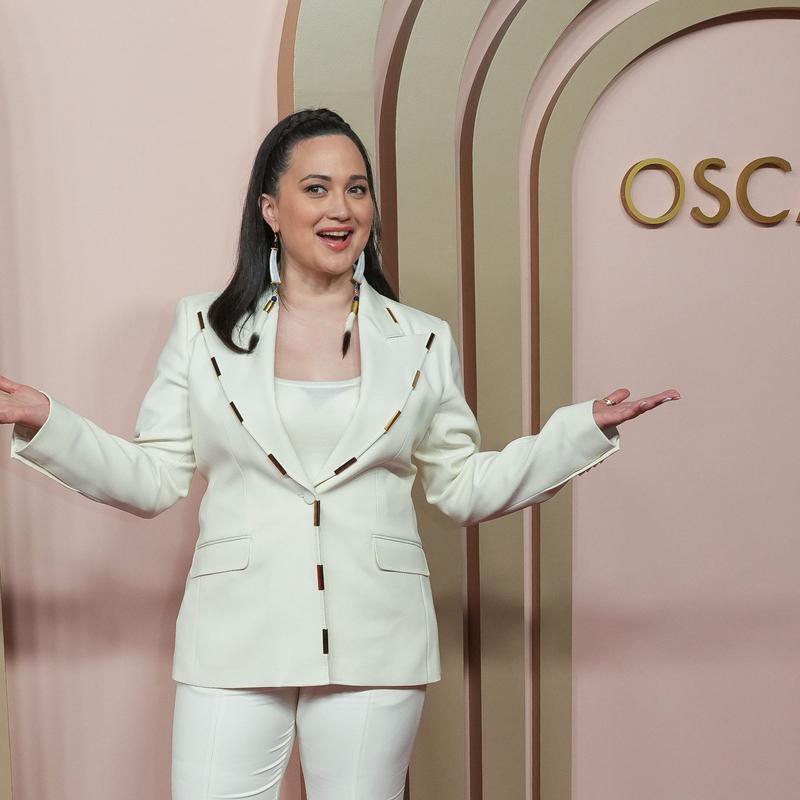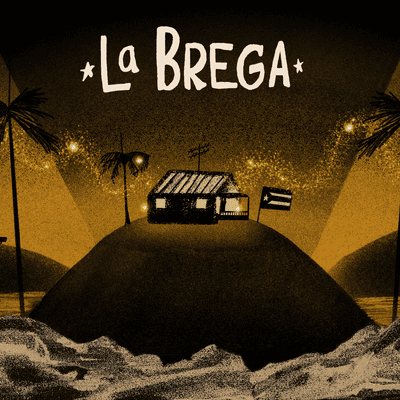Lily Gladstone on Oscar Hopes and Holding the Door Open

Speaker 1: Lily Gladstone has been in over a dozen films, including Kelly Reichardt's Certain Women, and she's been on Reservation Dogs created by Sterlin Harjo, but making a life as an actor, it's just not an easy thing. Gladstone said she was applying for seasonal work at the Department of Agriculture studying insects, which he heard from a certain Martin Scorsese. Scorsese eventually cast her as a lead and Killers of the Flower Moon. The film concerns a grizzly series of murders that took place in the Osage Nation after oil was discovered there.
Gladstone plays Mollie Burkhart, an Osage woman married to a white man named Ernest played in the film by Leonardo DiCaprio. Gladstone is nominated for the Academy Award for Best Actress, and that's a historic first for a native woman. She spoke recently with Michael Schulman, a staff writer at the New Yorker.
Michael Schulman: Your high school yearbook from Mountlake Terrace High School has made the rounds online. I know that you were voted most likely to win an Oscar. There's no question that's true.
Lily Gladstone: [laughs] It's really sweet. My graduating class, and then a lot of people that were in the same drama program, they're reuniting to watch the Oscars in our old high school theater. It's really touching.
Michael Schulman: Then you went and studied acting and directing at the University of Montana. I'm curious, when you got out what your early career was like. What kind of roles were you auditioning for, what were you getting and what kind of day jobs were you doing for survival?
Lily Gladstone: I decided to stay in Montana instead of going to LA or New York like a lot of my graduating class did because I felt like if I had gone to LA or New York and done the classic, just audition endlessly, hold down another job to support yourself, get an agent, get out there as much as possible. Just thinking about it was starting to kill my passion for it a little. I stayed in Montana where I had built some connections with some local filmmakers that I really liked. In between the theater tours, I auditioned for a one-woman show that toured into schools teaching about Native American boarding school experience. It was like a teacher-actor position that I had for a number of years.
Michael Schulman: Oh, I read about this. This was like you were acting against a recorded track in the school auditoriums. Can you tell me what that was?
Lily Gladstone: It's a Seattle-based company called Living Voices, and I was performing a show that was teaching about Native American boarding school experience and with historical documents projected behind you on the screen and pre-recorded voices from other actors that etch out this period in history. The character I played was Denay and she was a boarding school survivor who had gone through the Ganado Mission Hospital and trained to become a nurse and to become a nurse in World War II. Then was in a letter correspondence with her clan brother who had become a Navajo code talker.
I was teaching a little bit about that history as well. I did that for as many years as I could in my 20s, but got burned out on it because it's also a heavy task to walk in with this one specific curriculum, but finding that you have to do so much just 101 before you even start the show. Contextualizing that there's 574 different tribal nations in the United States. We all look different ways now and we all come from different backgrounds and we have a lot of different languages. Yes, we're still here, and no, we don't still live in teepees. A lot of us still have them, but not every native nation had lodges, just little things like that.
Michael Schulman: Right, and there's like a sophomore sleeping in the first row or something.
Lily Gladstone: Oh, yes.
Michael Schulman: Teens are a tough audience.
Lily Gladstone: Teens are the toughest audience. I know teachers at the middle school level get burned out, but I've found that middle schoolers are the best audience for that kind of thing. They're still young enough to really enjoy the theater of it and to buy into the magical realism suspension of disbelief. They're also sophisticated enough to grasp concepts of, yes, the assimilation policy was really bad for native people. It was really rewarding, but incredibly exhausting work as any teacher will attest. That job kept me going, supplementing between cashiering and staples, and then every once in a while, having an independent film that I would get to go do.
The assumption that I've also found as a native actor is there's a lot of roles that I've played now that's required that I speak another indigenous language, and by no means even fluent in Blackfeet. I can introduce myself. I have a few words and phrases. I know some of the bad words.
Michael Schulman: [laughs] Can you please curse in Blackfeet right now. I want to hear.
Lily Gladstone: [laughs] I'm just going to drop this from my Blackfeet folks, but I'm not going to say what it means. [Blackfeet language], one of the worst things and funniest things you can say about somebody. It's a fairly PG thing, but it's my favorite word in our language. I think that's an aspect of native performance that I think a lot of people take for granted is how hard it is. We celebrate other actors for picking up other, like European languages for a role for scenes and sounding proficient and fluent, but for some reason, that same awe and that same credit is often just dismissed for native actors because people assume, oh, that you all speak that. No, it's a huge gift to be able to speak an indigenous language.
Michael Schulman: I want to move on to Killers of the Flower Moon and your character, Mollie. The movie is based on the book by our colleague here at the New Yorker, David Grann. When you were figuring out how to play Mollie, she was a real person who made real choices and lived through very extreme circumstances. What was most familiar about her and what was the most enigmatic or obscure to you?
Lily Gladstone: In reading the book particularly, I got a sense of the kind of person that I was recognized, or that I would recognize in my own community. Like the woman I recognized from my grandma's side of the family, my [unintelligible 00:06:54] side. What was really exciting was the idea of having a chance to break some, not some boundaries but maybe some stereotypes with her as well in her relationship with her sisters. Because relationship that native women have with each other, especially our families, we love being together, we love joking, we love gossiping, and teasing.
I could really see that with my grandma's sisters, the way that they were together. Being very proper still, but just giggling about everything. That's not the native woman that you're used to seeing in cinema. You're used to seeing more like a stoic, kind of mean whatever. It's like, well, because there's outsiders around, people are-
Michael Schulman: Of course, right.
Lily Gladstone: -guarded. Like I said, I didn't want to overextend my own cultural understanding into Mollie as an Osage woman, but it was a basis. A lot of the familiarity I felt with her reminded me of stories I'd heard about my great-grandma, Lily, who I never met. She passed before I was born. I could hear echoed, I could see maybe where Grann had gotten his illustration, the way that he was able to sketch Mollie, the way that he drew her personality. I could feel that.
Michael Schulman: Mollie has a very strange and conflicted relationship with her husband, Ernest, played by Leonardo DiCaprio. I want zero in on my favorite scene in the film. A scene that's up there with the all-time great Martin Scorsese scenes, which is their first date when she invites them to dinner at her house and they're flirting, they're smoking, and she calls him out as a Coyote and says, "Coyote wants money," and then offers him whiskey.
Mollie Burkhart: [Osage language]
Ernest Burkhart: Coyote.
Mollie Burkhart: Coyote wants money.
Ernest Burkhart: That money is real nice. It's real nice. Especially if you're lazy like me. I won't sleep all day. I don't want to make a party when it's dark.
Mollie Burkhart: [laughs]
Ernest Burkhart: What's so funny?
Mollie Burkhart: Do you like [unintelligible 00:09:18].
Ernest Burkhart: Whiskey.
Mollie Burkhart: Yes.
Ernest Burkhart: I don't like whiskey, I love whiskey.
Mollie Burkhart: I have good whiskey. Not bad whiskey.
Ernest Burkhart: I think we should try some and find out.
Mollie Burkhart: [laughs]
Michael Schulman: Mollie is doing a lot in that scene. She's trying to figure this guy out, and in a way, she has, but in a way, she hasn't because, of course, he's plotting to marry into her family and take her oil money.
Lily Gladstone: Right. At that point, people were starting to pass away. It was a really difficult transitional time for Osage. This is als the first and second generation that had gone through boarding schools. Mollie and her sisters being boarding school survivors as well. There's a whole lot of contextualized history behind that. A lot of that also came from Charles Red Corn's book A Pipe for February, which talks about this period of time. It's a novel that writes about the Osage reign of terror from an Osage perspective and how as people are dying, the rise in paranoia was slow because there's a lot of things that community would attribute these deaths to that were related to historical trauma.
It wasn't immediately obvious that people were being poisoned to death. Like you see these new folks coming in, that initial wave is like, "Oh, these guys are new." There's a flirtation that happens, there's an exoticism that's happening on both sides. Me and the sisters definitely etched that out in that scene where we're gossiping about the men.
Mollie Burkhart: [Osage language]
Speaker 1: [Osage language]
Michael Schulman: What do you think that she sees in Ernest?
Lily Gladstone: It's a dynamic that I'm very used to seeing, even in my own family. Just it's a sustaining one, and I think you can find it in a lot of relationships. Just this fun-loving, larger-than-life, inappropriate, sometimes goofy cowboy of a guy with this very self-possessed, humble acting on protocol native woman that he just lives to crack her shell and make her laugh and how much joy she gets from that too. Just that back and forth. That scene underwent a couple of different changes. You pointed to it, the trickster element of it. It's not going to be explicitly clear to the audience when Mollie calls him [Osage language], he calls him Coyote.
She's not just calling him the animal, she's calling him a trickster. One of the trickster figures, an oral tradition with Osage is Coyote and there's several of them, but Coyotes like the firth. Is the one that's always tripping over his own feet, acting very hedonistic and self-interest, and he never really wins. He'll screw up everything for everybody involved in the story in a very funny way, especially when you're telling it to kids, but in the end, he just never wins.
When I was learning these stories, a lot of them just reminded me of our trickster stories, Blackfeet stories. Even though the structure's different, the landscape's different, the progression of the stories and the humor of them felt very familiar and it gave Ernest a place to hide.
Michael Schulman: It's funny, some of the movies that called to mind for me are actually these domestic dramas like Gaslight with Ingrid Bergman and Suspicion with Joan Fontaine and Cary Grant, these stories of women who are married to men who they slowly realize are terrorizing them. Of course that gets more acute as the film goes on. She is starting to realize that he's not only responsible for the deaths of her family members but is actively poisoning her through her insulin. For the audience, you reach a point where you want to scream at her to wake up and just run away from the guy, and yet she doesn't do that.
You start to wonder how much is she seeing right through him when he's lying to her face. How much is she deluding herself? I'm curious, was that the question for you as the story goes on?
Lily Gladstone: Where I found a place that Mollie would've had a huge blind spot in all of that, one, it's like what you suspect in your subconscious mind we've gotten conditioned to dismissing if what's right in front of us doesn't check out. He's so good with the kids and he's just doesn't seem capable of it. One of the biggest clues for me, especially during that period of time where Mollie's getting the insulin, the family has pretty much surmised she was also getting a combination of arsenic and morphine. There was the delivery process having a long time ago played a morphine addict in my first play and doing the research about that.
The chemical dependency on that and how the immediate relief of everything, that was a clue to me that, okay, Ernest is the delivery mechanism. While her subconscious and conscious mind are dancing with each other so much while her body is being eroded by arsenic but also healed by insulin and she's addicted to the whole process, the only thing that she sees consistently is Ernest that's bringing her this relief. When she does have a sober mind later unknowingly, that's how I approach those end scenes as well, is just people in my life I've been close to who are recovering addicts and were leaving toxic, abusive, codependent relationships, be it with people or be it with substance.
That was a big clue to me that gave me some compassion for what Mollie wasn't seeing, what she was incapable of seeing, and even if she was seeing and suspecting it, incapable of leaving, literally.
Michael Schulman: I am a studier of Oscar history and I know that in the past, it's been a real mixed experience for people who have been the first in their category. One story, Sidney Poitier, of course, was the first Black man to win best actor in 1964. Not after he won for Lilies of the Field, he was being honored at the mayor's office in New York City. The reporters kept asking him about civil rights and he finally snapped. He was not a person who generally snapped and said, "Why is it everything you guys ask refers to the Negroness of my life and not my acting?"
I'm curious if you have felt that tension of being out here as an actor, but also as the face of a community. In addition to that, you're playing an Osage woman, so it's not even quite your community.
Lily Gladstone: One thing that I've really appreciated is I'm friends with Sterlin Harjo, the creator of Reservation Dogs, and we're both in the circuit right now for both of these projects. When we were catching up and just visiting about this shared space we're finding ourselves navigating, he put it really well. He said, "We're in a position where we're kicking the door in." The reality of what that is and maybe what it has to be, when you kick the door in, you should just put your foot in the door and stand there. It's like kicking the door in and running through it means it's going to shut behind you.
It's really nice to remember that while I'm the first specifically Native American indigenous woman, there has been other representation. I stand on the shoulders of a lot of performers and it's circumstantial, this point in history, the film that I'm in, the performance that I was blessed enough to be able to carry. Still, it feels like a very shared moment and it feels like a big responsibility to just be and to celebrate others and to keep pushing for more representation. Because I've kicked the door in, I'm just trying to stand here and leave it open for everybody else to come through.
Michael Schulman: I will be looking forward to it. Also looking forward to the rest of this crazy award season. Congratulations again and it's been great talking to you. Thank you so much.
Lily Gladstone: Thank you, Michael.
Speaker 1: Lily Gladstone won a Golden Globe for her performance in Killers of the Flower Moon, and she's up for an Oscar in March. You can read michaelschulman@newyorker.com and he's the author of Oscar Wars: A History of Hollywood in Gold, Sweat, and Tears.
[music]
Copyright © 2024 New York Public Radio. All rights reserved. Visit our website terms of use at www.wnyc.org for further information.
New York Public Radio transcripts are created on a rush deadline, often by contractors. This text may not be in its final form and may be updated or revised in the future. Accuracy and availability may vary. The authoritative record of New York Public Radio’s programming is the audio record.





